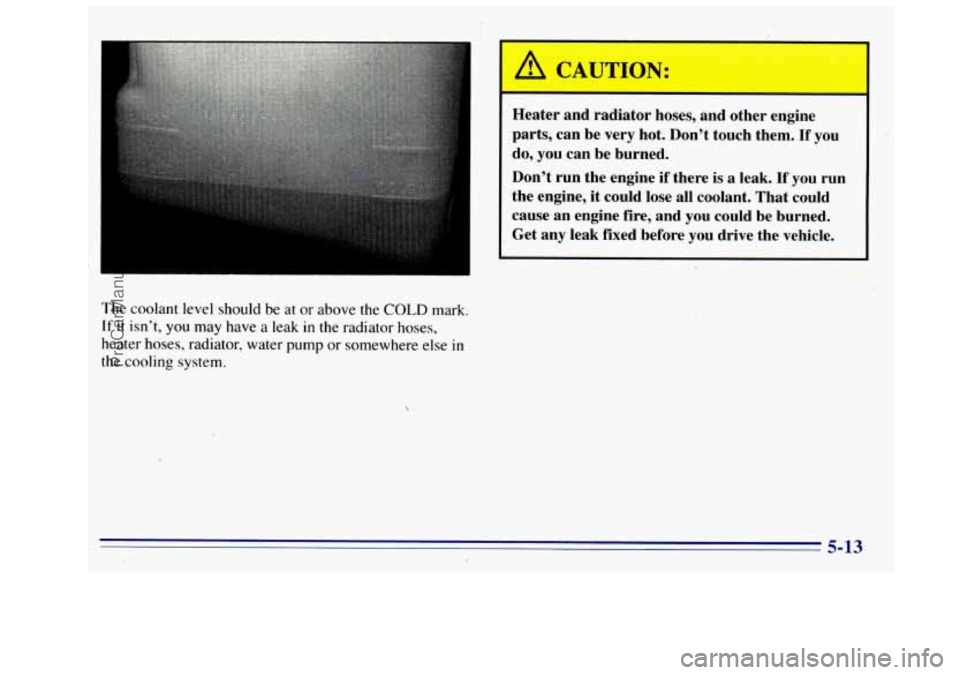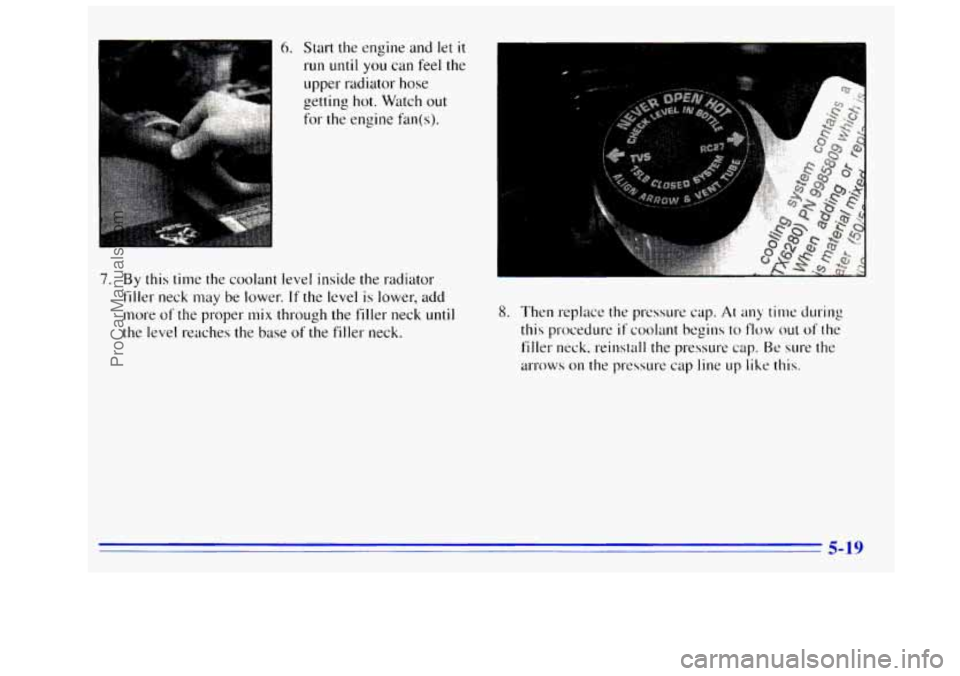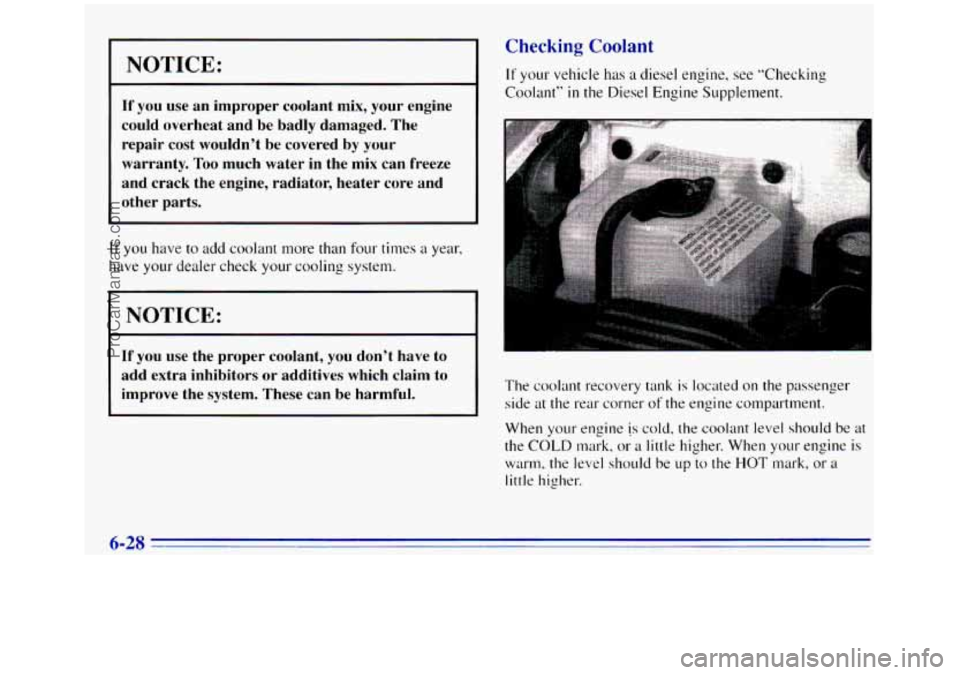1996 GMC SIERRA coolant level
[x] Cancel search: coolant levelPage 211 of 404

Turn Signals When Towing a Trailer
The green arrows on your instrument panel will flash
whenever
you signal a turn or lane change. Properly
hooked up, the trailer lamps will also flash, telling other
drivers you’re about to turn, change lanes or stop.
When towing a trailer, the green arrows
on your
instrument panel will flash for turns even
if the bulbs on
the trailer are burned out. Thus, you may
think drivers
behind
you are seeing your signal when they are not. It’s
important to check occasionally to be sure the trailer
bulbs are
still working.
Driving On Grades
Reduce speed and shift to a lower gear be~m you start
down
a long or steep downgrade. If you don’t shift
down,
you might have to use your brakes so much that
they would get hot and
no longer work well.
On a long uphill grade,
shift down and reduce your
speed
to around 45 mph (70 km/h) to reduce the
possibility
of engine and transmission overheating.
If you have an automatic transmission, you should use
THIRD
(3) (or, as you need to, a lower gear) when
towing a trailer. Operating your vehicle in THIRD
(3)
when towing a trailer will minimize heat build-up and
extend
the life of your transmission
If
you have a manual transmission and you are towing a
trailer,
it’s better not to use FIFTH (5) gear. Just drive in
FOURTH (4) gear (or, as you need to, a lower gear).
When towing at high altitude on steep uphill grades,
consider the following: Engine coolant will boil at a
lower temperature than at normal altitudes. If
you turn
your engine off‘ immediately after towing at high altitude
on steep uphill grades, your vehicle may show signs
similar
to engine overheating. To avoid this, let the
engine
run while parked (preferably on level ground)
with the automatic transmission
in PARK (P) (or the
manual transmission out
of gear and the parking brake
applied) for a few minutes before turning
the engine off.
If you do get the overheat warning, see “Engine
Overheating’’
in the Index.
ProCarManuals.com
Page 229 of 404

A CAUTION:
Heater and radiator hoses, and other engine
parts, can be very hot. Don't touch them.
If you
do, you can be burned.
Don't run the engine if there is a leak.
If you run
the engine, it could lose all coolant. That could
cause an engine fire, and you could be burned.
Get any leak fixed before you drive the vehicle.
The coolant level should be at or above the
COLD mark.
If it isn"t, you may have a leak in the radiator hoses,
heater hoses, radiator, water
pump or somewhere else in
the cooling system.
! 5-13
ProCarManuals.com
Page 230 of 404

NOTICE:
I
I
I
Engine damage from running your engine without coolant isn’t covered by your warranty.
If there seems to be no leak, start the engine again. See
if the fan speed increases when idle speed is doubled by
pushing the accelerator pedal down.
If it doesn’t, your
vehicle needs service. Turn
off the engine.
How to Add Coolant to the Coolant
Recovery Tank
If you haven’t found a problem yet, but the coolant level
isn’t at or above the
COLD mark, add a SO/SO mixture
of ciecu? wter (preferably distilled) and DEX-COOL”
(orange-colored, silicate-free) antifreeze at the coolant
recovery tank.
(See (‘Engine Coolant” in the Index for
more information.)
I A CAUTION:
Adding only plain water to your cooling system
can be dangerous. Plain water, or some other
liquid like
alcohol, can boil before the proper
coolant mix
will. Your vehicle’s coolant warning
system
is set for the proper coolant mix. With
plain water or the wrong mix, your engine could
get too hot but you wouldn’t get the overheat
warning. Your engine could catch fire and you or
others
could be burned. Use a 50/50 mix of clean
water and
DEX-COOL TM antifreeze.
I NOTICE:
In cold weather, water can freeze and crack
the engine, radiator, heater core and other parts.
Use the recommended coolant and the proper
coolant mix.
5- 14
ProCarManuals.com
Page 235 of 404

6. Start the engine and let it
run until you can feel the
upper radiator hose
getting
hot. Watch out
for the engine fan(s).
7. By this time the coolant level inside the radiator
filler neck may be lower.
If the level is lower, add
more of the proper mix through the filler neck until
the level reaches the base of the filler neck.
I
8. Then replace the pressure cap. At any time during
this procedure if coolant begins to flow out of the
filler neck. reinstall the pressure
cap. Be sure the
arrows
on the pressure cap line up like this.
5-19
ProCarManuals.com
Page 276 of 404

Front Axle
When to Check and Change Lubricant
Refer to the Maintenance Schedule to determine how
often
to check the lubricant and when to change it. See
"Scheduled Maintenance Services"
in the Index.
How to Check Lubricant
If the level is below the bottom of the filler plug hole.
you'll
need to add some lubricant.
If the differential is at operating temperature (warm),
add enough lubricant
to raise the level to the bottom of
the filler plug hole.
If the differential is cold, add enough lubricant to raise
the level
to 1/2 inch (1 2 mm) below the filler plug hole.
What to Use
Refer to the Maintenance Schedule to determine what
kind
of lubricant to use. See "Recommended Fluids and
Lubricants"
in the Index.
Engine Coolant
The cooling system in your vehicle is filled with new
DEX-COOL
TM (orange-colored, silicate-free) engine
coolant. This coolant is designed
to remain in your
vehicle for
5 years or 100,000 miles (1 66 000 km),
whichever occurs first.
The following explains
your cooling system and how
to add coolant when it is low. If you have a problem
with engine overheating, see "Engine Overheating"
in
the Index.
6-26
ProCarManuals.com
Page 278 of 404

NOTICE:
If you use an improper coolant mix, your engine
could overheat and be badly damaged. The
repair cost wouldn't be covered by your
warranty.
Too much water in the mix can freeze
and crack the engine, radiator, heater core and
other parts.
If you have to add coolant more than four times 8 year,
have
your dealer check your cooling system.
NOTICE:
If you use the proper coolant, you don't have to
add extra inhibitors or additives which claim to
improve the system. These can be harmful.
Checking Coolant
If your vehicle has a diesel engine, see "Clwcking
Coolant"
in the Diesel Engine Supplement.
d
The coolant recovery tank is located on the passenger
side at the rear corner of the engine compartment.
When your engine
is cold, the coolant level should be at
the
COLD mark, or a little higher. When your engine is
warm. the level sho~~ld be up to the HOT mark, or a
little higher.
6-28
ProCarManuals.com
Page 368 of 404

Part B: Owner Checks and Services
Listed below are owner checks and services which
should be performed at the intervals specified
to help
ensure the safety, dependability and emission control
performance
of your vehicle.
Be sure any necessary repairs are completed at once.
Whenever any fluids or lubricants are added to your
vehicle, make sure they are the proper
ones, as shown
in Part D.
At the First 100, 1,000 and 6,000 Miles
(160,1600 and 10 000 km)
For vehicles with dual wheels, check dual wheel nut
torque. For proper torque, see “Wheel Nut Torque” in
the Index.
At Each Fuel Fill
Engine Oil Level Check
Check the engine oil level and add the proper oil if necessary.
See “Engine Oil”
in the Index for further details.
Engine Coolant Level Check
Check the engine coolant level and add the proper
coolant mix
if necessary. See “Engine Coolant” in the
Index for further details.
Windshield Washer Fluid Level Check
Check the windshield washer fluid level in the
windshield washer tank and add the proper fluid
if
necessary. See “Windshield Washer Fluid” in the Index
for further details.
A Least Once a Month
Tire Inflation Check
Make sure tires are inflated to the correct pressures.
See “Tires”
in the Index for further details.
Cassette Deck Service
Clean cassette deck. Cleaning should be done every
50 hours of tape play. See “Audio Systems” in the
Index for further details.
7-42
ProCarManuals.com
Page 394 of 404

Engine ................................... 6.8. 6.10
Coolant
..................................... 6-26
Coolant Heater
............................... 2- 12
Coolant Level Check
.......................... 7-42
Coolant Temperature Gage
..................... 2-62
Cooling System Capacity
....................... 6-76
Exhaust
..................................... 2-30
Fuse Blocks
............................ 6.69. 6.71
Identification
................................ 6-67
OilLevelCheck
.............................. 7-42
Overheating
................................. 5- 10
Running While Parked ......................... 2-30
Specifications
................................ 6-74
StartingYour
................................ 2-11
Underhood Fusemelay Center
................... 6-7 I
Engine Oil .................................... 6- 12
Adding
..................................... 6-13
Additives
................................... 6-15
Checking
................................... 6-12
Pressure Gage
................................ 2-65
Used
....................................... 6-16
Whentochange
.............................. 6-15
Exhaust. Engine
................................ 2-30
Fabric Cleaning
............................... 6-59
Fan Control. Climate Control System
............ 3.1. 3.2
Fender Marker Lamp Bulb Replacement
............. 6-42
FillingYourTank
................................ 6-4
Filter. Air
..................................... 6-16
Finish Care
.................................... 6-63 Finish Damage
................................. 6-64
Flashers. Hazard Warning
......................... 5-1
Flat Tire. Changing
............................. 5-21
Fluid Capacities
................................ 6-76
Fluids and Lubricants
............................ 7-48
FogLamps
.................................... 2-41
Foreign Countries. Fuel
........................... 6-4
Four-wheel Drive
......................... 2-21. 6-25
French Language Manual
11
FrontAxle .................................... 6-26
Front Axle Locking Feature
....................... 2-21
FrontTowing
................................... 5-9
Front Turn Signal Lamp Bulb Replacement
..... 6.40. 6.41
Fuel
.......................................... 6-2
Filling Your Tank
.............................. 6-4
Gage
....................................... 2-68
In Foreign Countries
........................... 6-4
Tankcapacity
............................... 6-76
Fuses and Circuit Breakers
....................... 6-69
Fusible Links
.................................. 6-69
.. ...........................
Gages Engine Coolant Temperature
.................... 2-62
Engine Oil Pressure
........................... 2-65
Fuel
....................................... 2-68
Tachometer
.................................. 2-57
Voltmeter
................................... 2-60
Garage Door Opener
............................ 2-46
GAWR
....................................... 4-42
Speedometer
................................. 2-57
9-4 ..
I
ProCarManuals.com